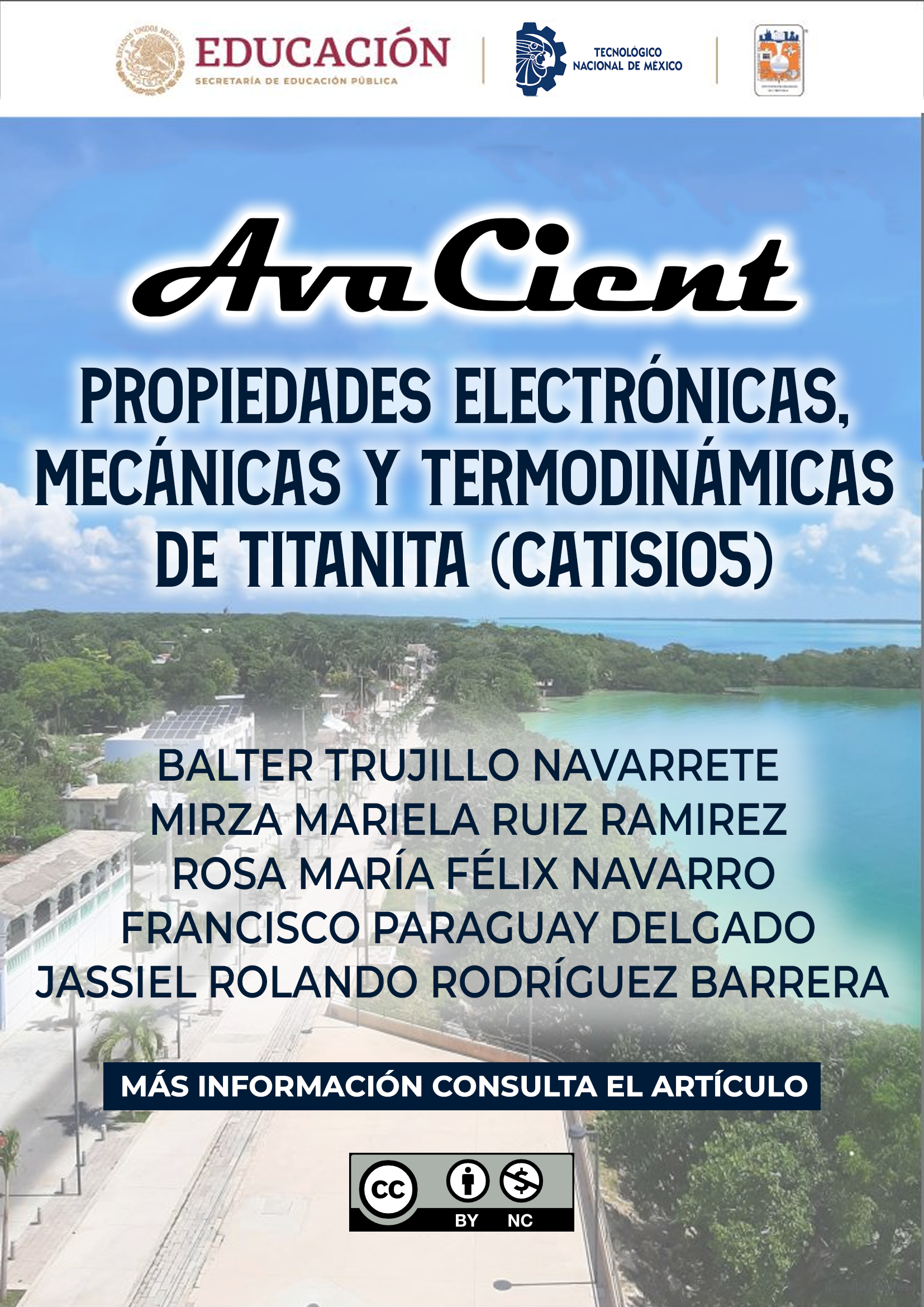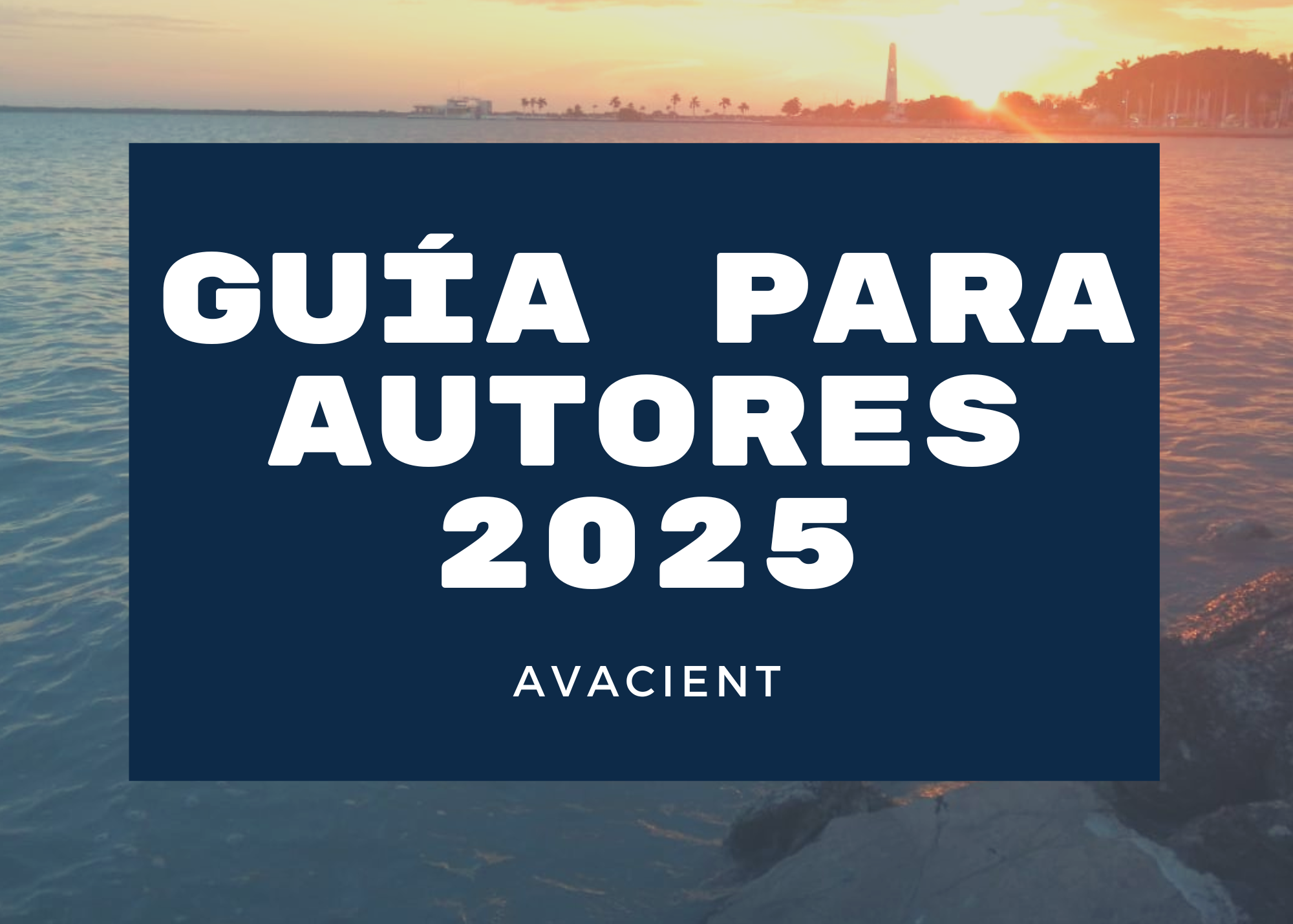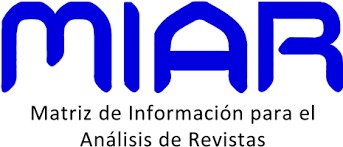PROPIEDADES ELECTRÓNICAS, MECÁNICAS Y TERMODINÁMICAS DE TITANITA (CaTiSiO5)
Palabras clave:
Titanita, CaTiSiO5, esfeno, DFT, diseño computacionalResumen
Los cálculos computacionales son una herramienta que nos permite profundizar en las propiedades de los nanomateriales. En el presente trabajo de investigación, se diseñó computacionalmente y se estudiaron las propiedades de la titanita utilizando la teoría funcional de la densidad. Mediante los cálculos de la teoría funcional de la densidad se buscaron las condiciones óptimas usando la aproximación de gradiente generalizada en la forma de Perdew-BurkeErnzerhof revisado. Se estudia la estructura de bandas electrónicas en función de la energía. También se estudian módulos elásticos, ductilidad o fragilidad, anisotropía elástica, estabilidad mecánica y rigidez de materiales sólidos. La entalpía, la entropía y la energía libre se informaron a partir de las propiedades vibratorias de los materiales. Se investigaron la capacidad calorífica dependiente de la temperatura y la temperatura de Debye. Las propiedades electrónicas mostraron que dado el valor de band gap (2.927 eV), la titanita puede usarse como un semiconductor. Las propiedades mecánicas reflejaron que el material es anisotrópico. Este estudio proporciona propiedades de la titanita obtenidas teóricamente, donde se observa la posible aplicación de la titanita como un soporte o catalizador
Descargas
Citas
Adivaiah, B., and G. Vaitheeswaran. 2021. “Computational Study of Lattice Dynamics and Thermodynamic Properties of Energetic Solid Cyanuric Triazide.” Journal of Physics and Chemistry of Solids 148(September 2020).
Angel, Ross J., Jennifer M. Jackson, Hans J. Reichmann, and Sergio Speziale. 2009. “Elasticity Measurements on Minerals: A Review.” European Journal of Mineralogy 21(3): 525–50.
Chen, Jianhua, Zhenghe Xu, and Ye Chen. 2020. “Introduction of Density Functional Theory.” In Electronic Structure and Surfaces of Sulfide Minerals, Elsevier, 1–12. https://linkinghub.elsevier.com/retrieve/pii/B9780128179741000016 (January 20, 2022).
Chen, S. K., and H. S. Liu. 1994. “FTIR, DTA and XRD Study of Sphene (CaTiSiO5) Crystallization in a Ceramic Frit and a Non-Borate Base Glass.” Journal of Materials Science 29(11): 2921–30.
Chen, Weiguang et al. 2012. “Electronic Properties of Anatase TiO2 Doped by Lanthanides: A DFT+U Study.”
Physica B: Condensed Matter 407(6): 1038–43.
Christensen, Rune, Thomas Bligaard, and Karsten Wedel Jacobsen. 2020. “Bayesian Error Estimation in Density Functional Theory.” In Uncertainty Quantification in Multiscale Materials Modeling, Elsevier, 77–91.
Clark, Stewart J. et al. 2005. “First Principles Methods Using CASTEP.” Zeitschrift fur Kristallographie 220(5–6): 567–70. https://www.degruyter.com/document/doi/10.1524/zkri.220.5.567.65075/html (August 10, 2022).
Cruz-Ortiz, B. R., D. A. Cortés-Hernández, M. L. Díaz-Jiménez, and J. E. Mauricio-Benavides. 2015. “Antibacterial Activity of TiO2-CaSiTiO5 Materials Synthesised from a Spent Catalyst.” Ceramics International 41(2): 2484– 91.
Das, Pratik Kr., Sudip Kumar Mondal, and Nibir Mandal. 2021. “First Principles Prediction of Exceptional Mechanical and Electronic Behaviour of Titanite (CaTiSiO5).” Materialia 15(November 2020): 100964.
Er, Dequan, and Kamalika Ghatak. 2020. “Atomistic Modeling by Density Functional Theory of Two-Dimensional Materials.” In Synthesis, Modeling, and Characterization of 2D Materials, and Their Heterostructures, Elsevier, 113–23.
Fareed, S., Arifa Jamil, M.A. Rafiq, and F. Sher. 2018. “Zinc Modified Cadmium Titanite Nanoparticles: Electrical and Room Temperature Methanol Sensing Properties.” Ceramics International 44(5): 4751–57.
Gaillac, Romain, Pluton Pullumbi, and François-Xavier Coudert. 2016. “ELATE: An Open-Source Online Application for Analysis and Visualization of Elastic Tensors.” Journal of Physics: Condensed Matter 28(27):
https://doi.org/10.1088/0953-8984/28/27/275201.
Hasan, Mehedi, Sharifa Nasrin, M. Nazrul Islam, and A. K.M.Akther Hossain. 2022. “First-Principles Insights into the Electronic, Optical, Mechanical, and Thermodynamic Properties of Lead-Free Cubic ABO3[A = Ba, Ca, Sr; B = Ce, Ti, Zr] Perovskites.” AIP Advances 12(8). https://doi.org/10.1063/5.0104191.
Huang, Z. W., Y. H. Zhao, H. Hou, and P. D. Han. 2012. “Electronic Structural, Elastic Properties and Thermodynamics of Mg17Al12, Mg2Si and Al2Y Phases from First-Principles Calculations.” Physica B: Condensed Matter 407(7): 1075–81.
Jarvis, Stephen H. 2022. The Temporal Mechanics XEMDIR Field Resolving Zero-Point Energy , Negative The Temporal Mechanics XEMDIR Field Resolving Zero-Point Energy , Negative Energy , Anti-EM , Anti-Gravity , Symmetry Breaking , and Baryon Asymmetry.
Jiang, Diyou et al. 2019. “Structural Stability, Electronic Structures, Mechanical Properties and Debye Temperature of Transition Metal Impurities in Tungsten: A First-Principles Study.” Metals 9(9).
Kohn, W., A. D. Becke, and R. G. Parr. 1996. “Density Functional Theory of Electronic Structure.” Journal of Physical Chemistry 100(31): 12974–80.
Lamuta, Caterina. 2019. “Elastic Constants Determination of Anisotropic Materials by Depth-Sensing Indentation.”
SN Applied Sciences 1(10): 1–13. https://doi.org/10.1007/s42452-019-1301-y.
Lawal, Abdullahi, Musa Bello, and Ahmed Musa Kona. 2022. “Quasi-Particle Band Structure and Optical Properties
of Perylene Crystal for Solar Cell Application : A G 0 W 0 Calculations.” 8(May): 187–95.
Li, Jinping, Songhe Meng, Liyuan Qin, and Hantao Lu. 2016. “First-Principles Study of Electronic Structure, Optical
and Phonon Properties of α-ZrW2O8.” Solid State Communications 247: 58–63.
Littlewood, Peter, and S̆ imon Kos. 2005. “Focus on the Fermi Surface.” Nature 438(7067): 435–435.
Liu, Zhong-Li. 2020. “High-Efficiency Calculation of Elastic Constants Enhanced by the Optimized Strain-Matrix Sets.” (January). http://arxiv.org/abs/2002.00005.
Mahmood, Q. et al. 2019. “The Study of Mechanical and Thermoelectric Behavior of MgXO3 (X = Si, Ge, Sn) for Energy Applications by DFT.” Chemical Physics 524: 106–12.
Malcherek, Thomas et al. 2004. “Isomorphy of Structural Phase Transitions in LiTaOSiO4, LiTaOGeO4 and Titanite, CaTiOSiO4.” Journal of Solid State Chemistry 177(10): 3254–62.
Malcherek, Thomas, and Michael Fischer. 2018. “Phase Transitions of Titanite CaTiSiO5 from Density Functional Perturbation Theory.” Physical Review Materials 2(2): 1–13.
Maletaškić, Jelena et al. 2017. “Phase Evolution of Sphene Based Ceramics during Annealing.” Energy Procedia
: 407–12.
Muz, İskender, Fahrettin Göktaş, and Mustafa Kurban. 2020. “3d-Transition Metals (Cu, Fe, Mn, Ni, V and Zn)- Doped Pentacene π-Conjugated Organic Molecule for Photovoltaic Applications: DFT and TD-DFT Calculations.” Theoretical Chemistry Accounts 139(2).
Niu, Juntian et al. 2020. “Methane Dry (CO2) Reforming to Syngas (H2/CO) in Catalytic Process: From Experimental Study and DFT Calculations.” International Journal of Hydrogen Energy 45(55): 30267–87.
Özer, Tahsin. 2019. “Study of First Principles on Anisotropy and Elastic Constants of Y3Al2 Compound.” Chinese Journal of Physics 61: 180–89.
Peng, Xiaoxiao et al. 2019. “Dielectric Properties of (Al3+,Nb5+) Co-Doped CaTiSiO5 Ceramics at Elevated Temperature.” Journal of Physics and Chemistry of Solids 132: 83–88.
Qu, Deyi, Longke Bao, Zhuangzhuang Kong, and Yonghua Duan. 2019. “Anisotropy of Elastic and Thermal Properties of TMOs2 (TM = Sc, Y, Ti, Zr and Hf) from First-Principles Explorations.” Materials Research Express 6(11): 0–11.
Santos, Pedro Paulo, and Luís F. Veiros. 2020. “Assistance of DFT Calculations on the Design and Rationalization of Active Pharmaceutical Ingredients Synthesis – Michael Addition-Isomerization Steps in Oseltamivir Synthesis.” Tetrahedron 76(51).
Saxena, Vimal, Michel Krief, and Ludmila Adam. 2018. Handbook of Borehole Acoustics and Rock Physics for Reservoir Characterization Anisotropy Evaluation.
Serir, N. et al. 2020. “Electronic, Elastic, Thermodynamic and Vibrational Properties of Li6BeZrF12: Insights from DFT-Based Computer Simulation.” Computational Condensed Matter 25.
Shapovalov, Victor et al. 2021. “Laboratory Operando Xas Study of Sodium Iron Titanite Cathode in the Li-Ion Half-Cell.” Nanomaterials 11(1): 1–13. https://doi.org/10.3390/nano11010156 (May 30, 2021).
Yin, Dan et al. 2018. “Self-Propagating High-Temperature Synthesis of Ce-Doped Sphene Mineral Using CuO as the Oxidant.” Progress in Nuclear Energy 105: 167–74.

Descargas
Publicado
Cómo citar
Número
Sección
Licencia
Derechos de autor 2023 AvaCient

Esta obra está bajo una licencia internacional Creative Commons Atribución-NoComercial 4.0.











